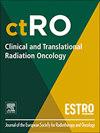空间分割放疗用于再照射:可行性、安全性、治疗计划和结果
IF 2.7
3区 医学
Q3 ONCOLOGY
引用次数: 0
摘要
空间分割放射治疗(SFRT)正在成为一种向大块疾病部位提供高剂量辐射的选择,与现有的放射治疗技术相比,其治疗率有所提高。以前没有研究过SFRT用于再照射。我们描述了3例先前放疗过的不同部位(肺、大腿和肾上腺)的大体积少转移性疾病患者,他们再次接受了SFRT治疗,目的是缓解或防止症状恶化。剂量处方为66.7 Gy,分5次至肿瘤总体积(GTV)均匀间隔的点阵点,计划靶体积(PTV)外围接受20 Gy,平均剂量约为27 Gy。剂量总和和图像配准技术,以及危险器官的选择和剂量限制,都是根据具体情况确定的。GTV体积从272 cm3到3183 cm3不等,给予PTV的平均剂量从26.2到27.4 Gy不等。两种治疗方案满足所有临床目标,而一种方案对两个结构有边际过量剂量。所有三名患者对SFRT的耐受性至少与初始放疗疗程一样好,没有发生严重的放射相关不良事件。2例患者在SFRT治疗前出现症状,治疗后症状得到显著改善。在姑息环境下,SFRT为大体积转移性疾病提供了一种可行且安全的再照射选择。本文章由计算机程序翻译,如有差异,请以英文原文为准。
Spatially fractionated radiotherapy for re-irradiation: feasibility, safety, treatment planning, and outcomes
Spatially fractionated radiotherapy (SFRT) is emerging as an option to deliver high dose radiation to bulky disease sites with an improved therapeutic ratio compared to established radiotherapy techniques. SFRT has not been previously studied for re-irradiation. We describe three patients with previously irradiated bulky oligometastatic disease to different sites (lung, thigh, and adrenal gland) who were re-treated with SFRT, with intention to relieve or prevent worsening of symptoms. Dose prescription was 66.7 Gy in 5 fractions to uniformly spaced lattice vertices in the gross tumour volume (GTV), with the planning target volume (PTV) receiving 20 Gy at the periphery and a mean dose of approximately 27 Gy. Dose summation and image registration techniques, and selection of organs at risk and dose constraints, were defined on a case-by-case basis. GTV volumes ranged from 272 cm3 to 3183 cm3, and mean dose delivered to the PTV ranged from 26.2 to 27.4 Gy. Two treatment plans met all clinical goals, while one plan had marginal excess dose to two structures. All three patients tolerated SFRT at least as well as their initial radiotherapy courses, with no severe radiation-related adverse events. Two patients were symptomatic prior to SFRT and achieved clinically significant symptom improvement following treatment. SFRT offers a feasible and safe re-irradiation option for bulky metastatic disease in the palliative setting.
求助全文
通过发布文献求助,成功后即可免费获取论文全文。
去求助
来源期刊

Clinical and Translational Radiation Oncology
Medicine-Radiology, Nuclear Medicine and Imaging
CiteScore
5.30
自引率
3.20%
发文量
114
审稿时长
40 days
 求助内容:
求助内容: 应助结果提醒方式:
应助结果提醒方式:


